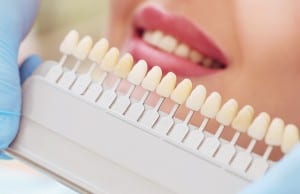
With the rise of cosmetic dentistry has come the introduction of many new techniques and procedures. Cosmetic dentistry otherwise known as aesthetic dentistry involves changing the appearance of teeth. This guide will give you an overview of what is involved in cosmetic dentistry and what training is required of dentists for them to become a cosmetic dentist.
What procedures are involved in cosmetic dentistry?
Dental Veneers
The leading cosmetic procedure for many years were dental veneers. These are thin layers of porcelain that fit over the front surface of a tooth and can be used to change the colour or shape of the tooth as well as filling spaces between teeth. However, recently there has been a step away from veneers due to the fact that the top surface of the tooth must be removed for a veneer to be placed with is destructive and non-reversible.
Straightening
Adult orthodontic treatment has become increasingly popular in the UK due to the development of technologies such as Invisalign. These “nearly invisible” braces offer an alternative to fixed metal braces and are more attractive to those undergoing orthodontic treatment later on in life.
Composite Bonding
Often used as an alternative to veneers, composite bonding involves shaping the teeth with composite resin material to make the teeth appear straighter, fix gaps in the teeth, discolouration or chipped teeth. The procedure is less destructive than the placement of veneers although it is not suitable in all cases.
Whitening
Tooth whitening is a procedure in which the natural colour of the tooth is lightened and stains from tea, coffee or smoking are removed. There are many different whitening techniques but the main method involves a dentist making a specialised mouthguard that fits over the teeth and is then filled with hydrogen or carbamide peroxide. As these compounds are broken down, oxygen is released which gets into the enamel and lightens the tooth colour.
Why do some beauty salons advertise whitening?
The General Dental Council issued guidance that only dentists could perform tooth whitening. They recently extended this to include dental hygienists, therapists and technicians who are able to whiten teeth on the prescription of a dentist. Due to this, it is not legal for those who are not registered with the GDC to perform tooth whitening.
Why are braces offered on the NHS to some patients and not others?
Orthodontic treatment is offered on the NHS to those under 18 who are deemed to require it for health reasons. This means that minor irregularities that are purely cosmetic are no longer corrected with orthodontic treatment on the NHS. Further details of the criteria can be found over at the British Orthodontic Society.
What training must a dentist complete to be a cosmetic dentist?
The short answer to this would be none, dentists are not required to undergo any additional training to become a “cosmetic dentist”. However, there are post graduate courses available hosted at universities or by cosmetic dentistry technology providers. In addition to this the British Academy of Cosmetic Dentistry offer courses, support an accreditation for Dentists that are interested in advancing their skills.
I hope that this guide has offered you an overview of the extensive field of cosmetic dentistry. It is a rapidly changing area so do keep an eye out for updates here at The Medic Portal.
Uploaded by Joelle on 12th October 2016
